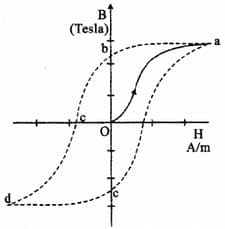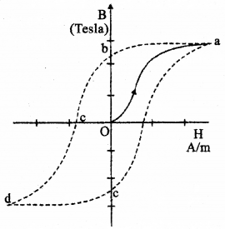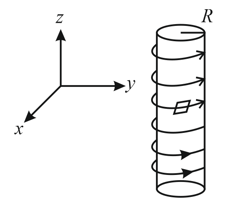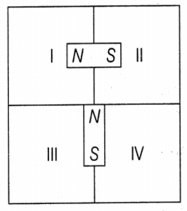EASY
Earn 100
Deduce an expression for magnetic dipole moment of an electron revolving around a nucleus in a circular orbit. Indicate the direction of magnetic dipole moment? Use the expression to derive the relation between the magnetic moment of an electron moving in a circle and its related angular momentum?
Important Questions on Ask questions about data to determine the factors that affect the strength of electric and magnetic forces.
EASY
Physical Sciences>Motion and Stability: Forces and Interactions>Ask questions about data to determine the factors that affect the strength of electric and magnetic forces.>Types of Interactions - Electric and magnetic (electromagnetic) forces can be attractive or repulsive, and their sizes depend on the magnitudes of the charges, currents, or magnetic strengths involved and on the distance between the interacting objects.
EASY
Physical Sciences>Motion and Stability: Forces and Interactions>Ask questions about data to determine the factors that affect the strength of electric and magnetic forces.>Types of Interactions - Electric and magnetic (electromagnetic) forces can be attractive or repulsive, and their sizes depend on the magnitudes of the charges, currents, or magnetic strengths involved and on the distance between the interacting objects.
EASY
Physical Sciences>Motion and Stability: Forces and Interactions>Ask questions about data to determine the factors that affect the strength of electric and magnetic forces.>Types of Interactions - Electric and magnetic (electromagnetic) forces can be attractive or repulsive, and their sizes depend on the magnitudes of the charges, currents, or magnetic strengths involved and on the distance between the interacting objects.
EASY
Physical Sciences>Motion and Stability: Forces and Interactions>Ask questions about data to determine the factors that affect the strength of electric and magnetic forces.>Types of Interactions - Electric and magnetic (electromagnetic) forces can be attractive or repulsive, and their sizes depend on the magnitudes of the charges, currents, or magnetic strengths involved and on the distance between the interacting objects.
Assertion: The magnetic field lines are continuous and form closed loops.
Reason: Magnetic monopole does not exist.
The correct option among the following is
MEDIUM
Physical Sciences>Motion and Stability: Forces and Interactions>Ask questions about data to determine the factors that affect the strength of electric and magnetic forces.>Types of Interactions - Electric and magnetic (electromagnetic) forces can be attractive or repulsive, and their sizes depend on the magnitudes of the charges, currents, or magnetic strengths involved and on the distance between the interacting objects.
EASY
Physical Sciences>Motion and Stability: Forces and Interactions>Ask questions about data to determine the factors that affect the strength of electric and magnetic forces.>Types of Interactions - Electric and magnetic (electromagnetic) forces can be attractive or repulsive, and their sizes depend on the magnitudes of the charges, currents, or magnetic strengths involved and on the distance between the interacting objects.
The Curve of a ferromagnetic material is as shown in figure:

A solenoid has a core of a material with relative permeability . The windings of the solenoid are insulated from the core and carry a current of . If the number of turns is Per metre, calculate magnetic intensity and magnetic field .
EASY
Physical Sciences>Motion and Stability: Forces and Interactions>Ask questions about data to determine the factors that affect the strength of electric and magnetic forces.>Types of Interactions - Electric and magnetic (electromagnetic) forces can be attractive or repulsive, and their sizes depend on the magnitudes of the charges, currents, or magnetic strengths involved and on the distance between the interacting objects.
EASY
Physical Sciences>Motion and Stability: Forces and Interactions>Ask questions about data to determine the factors that affect the strength of electric and magnetic forces.>Types of Interactions - Electric and magnetic (electromagnetic) forces can be attractive or repulsive, and their sizes depend on the magnitudes of the charges, currents, or magnetic strengths involved and on the distance between the interacting objects.
The Curve of a ferromagnetic material is as shown in figure:

Identify the value of retentivity and coercivity from the figure.
MEDIUM
Physical Sciences>Motion and Stability: Forces and Interactions>Ask questions about data to determine the factors that affect the strength of electric and magnetic forces.>Types of Interactions - Electric and magnetic (electromagnetic) forces can be attractive or repulsive, and their sizes depend on the magnitudes of the charges, currents, or magnetic strengths involved and on the distance between the interacting objects.
HARD
Physical Sciences>Motion and Stability: Forces and Interactions>Ask questions about data to determine the factors that affect the strength of electric and magnetic forces.>Types of Interactions - Electric and magnetic (electromagnetic) forces can be attractive or repulsive, and their sizes depend on the magnitudes of the charges, currents, or magnetic strengths involved and on the distance between the interacting objects.
Which of the field pattern given below is valid for electric field as well as for magnetic field?
MEDIUM
Physical Sciences>Motion and Stability: Forces and Interactions>Ask questions about data to determine the factors that affect the strength of electric and magnetic forces.>Types of Interactions - Electric and magnetic (electromagnetic) forces can be attractive or repulsive, and their sizes depend on the magnitudes of the charges, currents, or magnetic strengths involved and on the distance between the interacting objects.
HARD
Physical Sciences>Motion and Stability: Forces and Interactions>Ask questions about data to determine the factors that affect the strength of electric and magnetic forces.>Types of Interactions - Electric and magnetic (electromagnetic) forces can be attractive or repulsive, and their sizes depend on the magnitudes of the charges, currents, or magnetic strengths involved and on the distance between the interacting objects.

EASY
Physical Sciences>Motion and Stability: Forces and Interactions>Ask questions about data to determine the factors that affect the strength of electric and magnetic forces.>Types of Interactions - Electric and magnetic (electromagnetic) forces can be attractive or repulsive, and their sizes depend on the magnitudes of the charges, currents, or magnetic strengths involved and on the distance between the interacting objects.
MEDIUM
Physical Sciences>Motion and Stability: Forces and Interactions>Ask questions about data to determine the factors that affect the strength of electric and magnetic forces.>Types of Interactions - Electric and magnetic (electromagnetic) forces can be attractive or repulsive, and their sizes depend on the magnitudes of the charges, currents, or magnetic strengths involved and on the distance between the interacting objects.

Given that there is a neutral point it is located in,
EASY
Physical Sciences>Motion and Stability: Forces and Interactions>Ask questions about data to determine the factors that affect the strength of electric and magnetic forces.>Types of Interactions - Electric and magnetic (electromagnetic) forces can be attractive or repulsive, and their sizes depend on the magnitudes of the charges, currents, or magnetic strengths involved and on the distance between the interacting objects.

MEDIUM
Physical Sciences>Motion and Stability: Forces and Interactions>Ask questions about data to determine the factors that affect the strength of electric and magnetic forces.>Types of Interactions - Electric and magnetic (electromagnetic) forces can be attractive or repulsive, and their sizes depend on the magnitudes of the charges, currents, or magnetic strengths involved and on the distance between the interacting objects.
EASY
Physical Sciences>Motion and Stability: Forces and Interactions>Ask questions about data to determine the factors that affect the strength of electric and magnetic forces.>Types of Interactions - Electric and magnetic (electromagnetic) forces can be attractive or repulsive, and their sizes depend on the magnitudes of the charges, currents, or magnetic strengths involved and on the distance between the interacting objects.
MEDIUM
Physical Sciences>Motion and Stability: Forces and Interactions>Ask questions about data to determine the factors that affect the strength of electric and magnetic forces.>Types of Interactions - Electric and magnetic (electromagnetic) forces can be attractive or repulsive, and their sizes depend on the magnitudes of the charges, currents, or magnetic strengths involved and on the distance between the interacting objects.
MEDIUM
Physical Sciences>Motion and Stability: Forces and Interactions>Ask questions about data to determine the factors that affect the strength of electric and magnetic forces.>Types of Interactions - Electric and magnetic (electromagnetic) forces can be attractive or repulsive, and their sizes depend on the magnitudes of the charges, currents, or magnetic strengths involved and on the distance between the interacting objects.
HARD
Physical Sciences>Motion and Stability: Forces and Interactions>Ask questions about data to determine the factors that affect the strength of electric and magnetic forces.>Types of Interactions - Electric and magnetic (electromagnetic) forces can be attractive or repulsive, and their sizes depend on the magnitudes of the charges, currents, or magnetic strengths involved and on the distance between the interacting objects.

